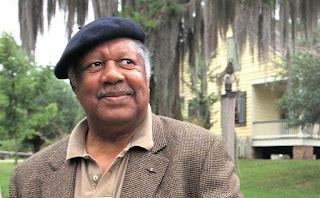Every day brings a new story. And each day contributes to the art of story telling -- in prose and poetry, in music, on the stage, on the screen, and, of course, in books.
A blog about reviewing what's in my TBR stack. The daily Almanac of Story Tellers. This Week in Books.
Book Recommendations
This Week in Books
Featured Post
January 31, 2022
Almanac of Story Tellers: Langston Hughes
January 30, 2022
Almanac of Story Tellers: Norman Mailer
Every day brings a new story. And each day contributes to the art of story telling -- in prose and poetry, in music, on the stage, on the screen, and, of course, in books.
_______________________________________________________________________________
January 29, 2022
Almanac of Story Tellers: Barbara Tuchman
Every day brings a new story. And each day contributes to the art of story telling -- in prose and poetry, in music, on the stage, on the screen, and, of course, in books.
_______________________________________________________________________________
January 28, 2022
Almanac of Story Tellers: Germaine Greer
Every day brings a new story. And each day contributes to the art of story telling -- in prose and poetry, in music, on the stage, on the screen, and, of course, in books.
_______________________________________________________________________________
On this date in 1938, the feminist intellectual and author Germaine Greer was born in Melbourne, Australia.
Privileged women will pluck at your sleeve and seek to enlist you in the "fight" for reforms, but reforms are retrogressive. The old process must be broken, not made new. Bitter women will call you to rebellions, but you have too much to do. What will you do?
Greer attended and graduated from universities in Australia before moving to Cambridge, England, for her doctorate. She lectured and lived in Italy for a time, has traveled frequently through the United States, but has lived mostly in England.
January 27, 2022
Almanac of Story Tellers: Yale Daily News
Every day brings a new story. And each day contributes to the art of story telling -- in prose and poetry, in music, on the stage, on the screen, and, of course, in books.
_______________________________________________________________________________
January 26, 2022
Almanac of Story Tellers: Lewis Carroll
Every day brings a new story. And each day contributes to the art of story telling -- in prose and poetry, in music, on the stage, on the screen, and, of course, in books.
_______________________________________________________________________________
January 25, 2022
Almanac of Story Tellers: Apollo Theater
Every day brings a new story. And each day contributes to the art of story telling -- in prose and poetry, in music, on the stage, on the screen, and, of course, in books.
_______________________________________________________________________________
January 24, 2022
Almanac of Story Tellers: Robert Burns
Every day brings a new story. And each day contributes to the art of story telling -- in prose and poetry, in music, on the stage, on the screen, and, of course, in books.
_______________________________________________________________________________
Burns was brought up in a tenant-farming family, and the life of hardship and hard manual labor had an effect on both his physical abilities and his writing sensitivities. In the class-ridden society of the late 18th Century Scotland, he could never rise above his raising and poor education, and his poetry shows his distaste for the wealthy elite and their religion and Calvinistic morals.
Book Review: A Darker Shade of Magic
- Author: V.E. Schwab
- Where I bought this book: Roebling Books and Coffee, Newport, Ky.
- Why I bought this book: A tale of many Londons intrigued me.
******** Sometimes, when you're reading a novel with magical inspirations, you just have to let go and forge ahead. You may not completely understand what is happening or why it is taking place, so you keep reading, enjoy the moment, and hang on for the ride.
Such is the case with this mesmerizing, bizarre, and oddly enchanting book, first published in 2016. I didn't know when I picked it up that it's the first in a series. I have since learned it's a trilogy, and the next two books are in the TBR Stack.
I fell in love with the story, along with its remarkable and compelling characters. Those include Kell, a foremost practictioner of the art of magic, and Lila, an edgy, cunning castaway living on the streets of London.
Actually, Lila lives in one of the four Londons -- Grey London, the dullest and most realistical of the Londons with King George III at its helm and of its magic gone. Meanwhile, Kell lives in Red London as the magic emissary for the Maresh Empire. He is one of the few remaining Antari, who can travel between the various Londons.
Except for Black London. No one goes there because nothing exisits but pure evil.
Kell does visit White London, though, where trouble is brewing. White London has evil magic, and is run by those who are selfish and cruel.
That's because, as Kell explains, magic is in the blood. Literally. Red is the color of magic in balance, of harmony between power and humanity. Black is the color of magic without balance, without order, without restraint. (I'm not sure how White fits into this scheme, unless it's what happens to magic as it's going bad.)
Anyway, the story has Kell being not only an emissary, but a smuggler between the Londons. This is illegal, and could bring about severe punishment if he is caught. But Kell does it for fun, partly because he is bored.
Lila -- remember Lila? -- lives and works on the street. She and Kell find each other, for better or for worse, and must work together keep the magic in balance and save Red London. It's tough for both of them.
It's a wild ride. Hang on and trust the writer. You'll find it worth your while.
January 23, 2022
Almanac of Story Tellers: Edith Wharton
Every day brings a new story. And each day contributes to the art of story telling -- in prose and poetry, in music, on the stage, on the screen, and, of course, in books.
_______________________________________________________________________________
January 22, 2022
Almanac of Story Tellers: Rock and Roll Hall of Fame
Every day brings a new story. And each day contributes to the art of story telling -- in prose and poetry, in music, on the stage, on the screen, and, of course, in books.
_______________________________________________________________________________
 On this date in 1986, the first group of artists were inducted into the Rock and Roll Hall of Fame in Cleveland.
On this date in 1986, the first group of artists were inducted into the Rock and Roll Hall of Fame in Cleveland.January 21, 2022
Almanac of Story Tellers: D.W. Griffith
Every day brings a new story. And each day contributes to the art of story telling -- in prose and poetry, in music, on the stage, on the screen, and, of course, in books.
_______________________________________________________________________________
January 20, 2022
Book Review: Same Sun Here
- Authors: Silas House and Neela Vaswani
- Where I bought this book: The 2021 Kentucky Book Fair, Lexington
- Why I bought this book: Silas House signed it.
Two strong writers have put together a pleasant read from the fictional correspondence between dissimilar yet emotionally connected youngsters.
House's River Justice is a 12-year-old boy, the son of a coal miner in Eastern Kentucky. Meena Joshi is a 12-year-old immigrant from India, living in New York City's Chinatown. As part of a school assignment, Meena randomly selects River to be her pen-pal, and the pair begin to explore each other, their backgrounds, their lives, and their thoughts about their places in the world.
It's a compelling read that shows the best of today's younger generation -- thoughtful, mindful, and caring. They discover they have many things in common, and while Meena's young childhood in India gives her some insight into River's rural Kentucky life, he is forever asking questions about New York's urban lifestyle and Meena's role in it.
This is a book written like it is by young adults, for young adults.
House writes River's letters. His language is remarkable. He uses the Eastern Kentucky dialect subtly, easily capturing the rhythms and tones of his home. He gives River his distinctive Appalachian inflections -- yes, you can hear him speaking.
Vaswani is House's equal in presenting Meena's outgoing yet thoughtful pre-teen voice. Like any 12-year-old girl, she has to ability to change tone within seconds. One sentence she write as foot-stomping angry, and the next returns as the calm, compassionate friend.
As they learn about each other, they find their worlds are being threatened. Meena sees her neighborhood changing and casting aside some who have lived in their rent-controled apartments their entire lives. The cause is the landlord's desire to increase their rent or force them out and sell the apartment for a high profit. To make the apartments unliveable for the current residents, they withhold servuves or refuse to perform routine maintenance.
Likewise, River sees his beloved mountains and woods being destroyed to bring out more coal. The coal barons are literally stripping away the mountaintops to get to the coal seams, in the process dumping toxic waste wherever they can -- usually in the rivers and streams.
The difference is the landlords are deliberately being cruel, while the coal barons don't care.
Both youths explain what is going one and how they and their communities are fighting it as best they can. So at its best it's a hopeful story, one befitting the authors who are telling it in the voices of the youths who are living it.
Almanac of Story Tellers: First American Novel
Every day brings a new story. And each day contributes to the art of story telling -- in prose and poetry, in music, on the stage, on the screen, and, of course, in books.
_______________________________________________________________________________
January 19, 2022
Almanac of Story Tellers: Lead Belly
Every day brings a new story. And each day contributes to the art of story telling -- in prose and poetry, in music, on the stage, on the screen, and, of course, in books.
_______________________________________________________________________________
January 18, 2022
Almanac of Story Tellers: Janis Joplin
Every day brings a new story. And each day contributes to the art of story telling -- in prose and poetry, in music, on the stage, on the screen, and, of course, in books.
_______________________________________________________________________________
January 17, 2022
Almanac of Story Tellers: A.A. Milne
Every day brings a new story. And each day contributes to the art of story telling -- in prose and poetry, in music, on the stage, on the screen, and, of course, in books.
_______________________________________________________________________________
January 15, 2022
Almanac of Story Tellers: Miguel de Cervantes
Every day brings a new story. And each day contributes to the art of story telling -- in prose and poetry, in music, on the stage, on the screen, and, of course, in books.
_______________________________________________________________________________
January 14, 2022
Almanac of Story Tellers: Earnest Gaines
Every day brings a new story. And each day contributes to the art of story telling -- in prose and poetry, in music, on the stage, on the screen, and, of course, in books.
_______________________________________________________________________________
Book Review
The Underground Railroad, by Colin Whitehead
- Where I bought this book: The Book Loft, Columbus, Ohio
- Why I bought this book: It is written by Colin Whitehead
January 13, 2022
Almanac of Story Tellers: The Today Show
Every day brings a new story. And each day contributes to the art of story telling -- in prose and poetry, in music, on the stage, on the screen, and, of course, in books.
_______________________________________________________________________________
January 12, 2022
Almanac of Story Tellers: Horatio Alger
Every day brings a new story. And each day contributes to the art of story telling -- in prose and poetry, in music, on the stage, on the screen, and, of course, in books.
_______________________________________________________________________________
January 11, 2022
Almanac of Story Tellers: Walter Mosley
Every day brings a new story. And each day contributes to the art of story telling -- in prose and poetry, in music, on the stage, on the screen, and, of course, in books.
























